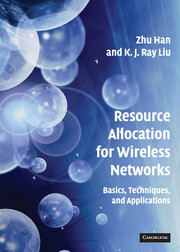Book contents
- Frontmatter
- Contents
- Preface
- 1 Introduction
- Part I Basics Principles
- Part II Optimization Techniques for Resource Allocation
- Part III Advanced Topics
- 10 Resource Allocation with Antenna-Array Processing
- 11 Dynamic Resource Allocation
- 12 Resource Allocation for Cooperative Networks
- 13 Game-Theoretic Approaches for Resource Allocation
- 14 Ad Hoc/Sensor/Personal-Area Networks
- 15 Resource Allocation for Wireless Multimedia
- Bibliography
- Index
11 - Dynamic Resource Allocation
from Part III - Advanced Topics
Published online by Cambridge University Press: 05 August 2012
- Frontmatter
- Contents
- Preface
- 1 Introduction
- Part I Basics Principles
- Part II Optimization Techniques for Resource Allocation
- Part III Advanced Topics
- 10 Resource Allocation with Antenna-Array Processing
- 11 Dynamic Resource Allocation
- 12 Resource Allocation for Cooperative Networks
- 13 Game-Theoretic Approaches for Resource Allocation
- 14 Ad Hoc/Sensor/Personal-Area Networks
- 15 Resource Allocation for Wireless Multimedia
- Bibliography
- Index
Summary
Introduction
Over the past few decades, wireless communications and networking have witnessed an unprecedented growth and have become pervasive much sooner than anyone could have imagined. In wireless communication systems, two important detrimental effects that decrease network performance are the channel's time-varying nature and CCI. Because of effects such as multipath fading, shadowing, path loss, propagation delay, and noise level, the SINR at a receiver output can fluctuate on the order of tens of decibels. The other major challenge for the system design is the limited available RF spectrum. Channel reuse is a common method used to increase the wireless system capacity by reusing the same channel beyond some distance. However, this introduces CCI that degrades the link quality.
A general strategy to combat these detrimental effects is the dynamic allocation of resources such as transmitted power, modulation rates, channel assignment, and scheduling based on the channel conditions. Power control is one direct approach toward minimizing CCI. The transmit power is constantly adjusted. They are increased if the SINRs at the receivers are low and are decreased if the SINRs are high. Such a process improves the quality ofweak links and reduces the unnecessary transmit power. In [2, 92] centralized power control schemes are proposed to balance the carrier-to-interference ratio (CIR) or maximize the minimum CIR in all links. Those algorithms need global information about all link gains and power. The distributed power control algorithms that use only local measurements of SINR are presented in [209, 352].
Information
- Type
- Chapter
- Information
- Resource Allocation for Wireless NetworksBasics, Techniques, and Applications, pp. 263 - 303Publisher: Cambridge University PressPrint publication year: 2008
